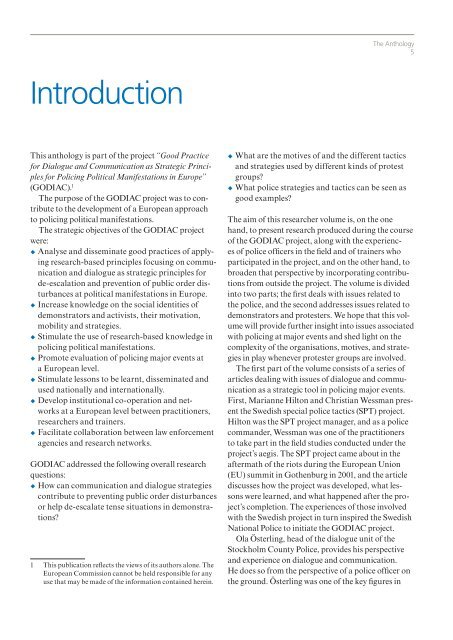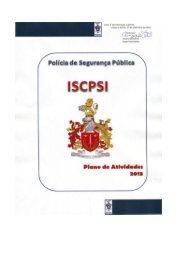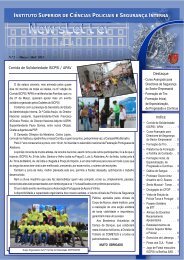The Anthology
The Anthology
The Anthology
You also want an ePaper? Increase the reach of your titles
YUMPU automatically turns print PDFs into web optimized ePapers that Google loves.
<strong>The</strong> <strong>Anthology</strong><br />
5<br />
Introduction<br />
This anthology is part of the project “Good Practice<br />
for Dialogue and Communication as Strategic Principles<br />
for Policing Political Manifestations in Europe”<br />
(GODIAC). 1<br />
<strong>The</strong> purpose of the GODIAC project was to contribute<br />
to the development of a European approach<br />
to policing political manifestations.<br />
<strong>The</strong> strategic objectives of the GODIAC project<br />
were:<br />
Analyse and disseminate good practices of applying<br />
research-based principles focusing on communication<br />
and dialogue as strategic principles for<br />
de-escalation and prevention of public order disturbances<br />
at political manifestations in Europe.<br />
Increase knowledge on the social identities of<br />
demonstrators and activists, their motivation,<br />
mobility and strategies.<br />
Stimulate the use of research-based knowledge in<br />
policing political manifestations.<br />
Promote evaluation of policing major events at<br />
a European level.<br />
Stimulate lessons to be learnt, disseminated and<br />
used nationally and internationally.<br />
Develop institutional co-operation and networks<br />
at a European level between practitioners,<br />
researchers and trainers.<br />
Facilitate collaboration between law enforcement<br />
agencies and research networks.<br />
GODIAC addressed the following overall research<br />
questions:<br />
How can communication and dialogue strategies<br />
contribute to preventing public order disturbances<br />
or help de-escalate tense situations in demonstrations?<br />
1 This publication reflects the views of its authors alone. <strong>The</strong><br />
European Commission cannot be held responsible for any<br />
use that may be made of the information contained herein.<br />
What are the motives of and the different tactics<br />
and strategies used by different kinds of protest<br />
groups?<br />
What police strategies and tactics can be seen as<br />
good examples?<br />
<strong>The</strong> aim of this researcher volume is, on the one<br />
hand, to present research produced during the course<br />
of the GODIAC project, along with the experiences<br />
of police officers in the field and of trainers who<br />
participated in the project, and on the other hand, to<br />
broaden that perspective by incorporating contributions<br />
from outside the project. <strong>The</strong> volume is divided<br />
into two parts; the first deals with issues related to<br />
the police, and the second addresses issues related to<br />
demonstrators and protesters. We hope that this volume<br />
will provide further insight into issues associated<br />
with policing at major events and shed light on the<br />
complexity of the organisations, motives, and strategies<br />
in play whenever protester groups are involved.<br />
<strong>The</strong> first part of the volume consists of a series of<br />
articles dealing with issues of dialogue and communication<br />
as a strategic tool in policing major events.<br />
First, Marianne Hilton and Christian Wessman present<br />
the Swedish special police tactics (SPT) project.<br />
Hilton was the SPT project manager, and as a police<br />
commander, Wessman was one of the practitioners<br />
to take part in the field studies conducted under the<br />
project’s aegis. <strong>The</strong> SPT project came about in the<br />
aftermath of the riots during the European Union<br />
(EU) summit in Gothenburg in 2001, and the article<br />
discusses how the project was developed, what lessons<br />
were learned, and what happened after the project’s<br />
completion. <strong>The</strong> experiences of those involved<br />
with the Swedish project in turn inspired the Swedish<br />
National Police to initiate the GODIAC project.<br />
Ola Österling, head of the dialogue unit of the<br />
Stockholm County Police, provides his perspective<br />
and experience on dialogue and communication.<br />
He does so from the perspective of a police officer on<br />
the ground. Österling was one of the key figures in






